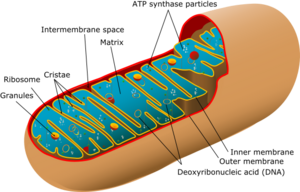Mitochondria facts for kids
Mitochondria are tiny parts, called organelles, found inside most eukaryotic cells. Think of them as miniature power plants within your body's cells! They are located in the cytoplasm, which is the jelly-like substance filling the cell, outside of the nucleus.
Their main job is to create most of the cell's energy supply. They do this by making a special molecule called ATP. Cells use ATP as their main source of energy to do everything they need, like growing, moving, and repairing themselves. This process of making ATP is called cellular respiration.
Besides making energy, mitochondria also help with other important cell activities. They are involved in sending signals, helping cells become different types (like a skin cell or a muscle cell), and even controlling when a cell dies. They also play a role in how cells grow and divide.
Contents
Structure of Mitochondria
Each mitochondrion has two main membranes: an outer one and an inner one. These membranes are made of special fats called phospholipids and proteins. The two membranes are different from each other.
Because of these two membranes, there are five distinct areas inside a mitochondrion:
- The outer mitochondrial membrane.
- The intermembrane space, which is the area between the outer and inner membranes.
- The inner mitochondrial membrane.
- The cristae space, which is formed by the many folds of the inner membrane.
- The matrix, which is the space inside the inner membrane.
How Mitochondria Work
The main job of mitochondria is to take glucose (a type of sugar) and turn its stored energy into ATP. This process is called cellular respiration. It has three main steps:
- Glycolysis
- The citric acid cycle
- ATP Synthesis
Once ATP is made, it leaves the mitochondria. Other parts of the cell then use this ATP to power their own functions and keep the cell working.
Mitochondria and DNA
Scientists believe that mitochondria were once independent bacteria. They think that, a very long time ago, these bacteria were "swallowed" by larger eukaryotic cells. This idea is called endosymbiosis. Instead of being digested, the bacteria stayed inside and started working with the host cell.
Most of a cell's DNA is found in its cell nucleus. However, mitochondria have their very own genome, which is a complete set of their own DNA. This mitochondrial DNA is quite similar to the DNA found in bacteria.
You might see mitochondrial DNA called either mDNA or mtDNA by scientists. Both terms mean the same thing.
How Mitochondria Are Passed Down
Mitochondria divide in a way similar to how bacteria divide, a process called binary fission. In simple, single-celled organisms, mitochondria divide when the cell divides. This makes sure each new cell gets at least one mitochondrion. In more complex organisms, like humans, mitochondria can divide and make more copies of their DNA based on how much energy the cell needs.
The genes in mitochondria are passed down differently from the genes in the cell's nucleus. Usually, all the mitochondria, and therefore all the mitochondrial DNA, come only from the egg cell. When a sperm enters an egg, its mitochondria are usually destroyed. The egg cell has a small number of mitochondria, but these are the ones that survive and multiply to fill the cells of the new organism.
This means that mitochondria are almost always inherited from the mother. This is called maternal inheritance. This is true for all animals and most other living things. However, in some conifer trees (but not pines or yews), mitochondria can be inherited from the father.
A single mitochondrion can have 2 to 10 copies of its own DNA. It's thought that this DNA reproduces by making exact copies through binary fission. However, there is some evidence that animal mitochondria can sometimes mix their DNA, a process called recombination.
Studying Populations with Mitochondrial DNA
Because mitochondrial DNA usually doesn't mix much (recombine), it's very useful for studying how groups of living things have changed over time. If all mitochondrial DNA is passed down as a single unit, scientists can create a "family tree" of mitochondrial DNA from different individuals.
These "gene trees" can help us understand the history of populations. For example, by looking at mitochondrial DNA, scientists have estimated when a common female ancestor, sometimes called "mitochondrial Eve," lived. This supports the idea that modern humans spread out of Africa. Another example is studying mitochondrial DNA from Neanderthal bones. The differences between Neanderthal mitochondrial DNA and human mitochondrial DNA suggest that Neanderthals and modern humans didn't interbreed much.
However, remember that mitochondrial DNA only shows the history passed down through females. It might not tell the whole story of a population. To get a complete picture, scientists also study DNA from the Y chromosome (which comes from the father) and the nuclear DNA (from both parents).
Related pages
Images for kids
See also
 In Spanish: Mitocondria para niños
In Spanish: Mitocondria para niños








